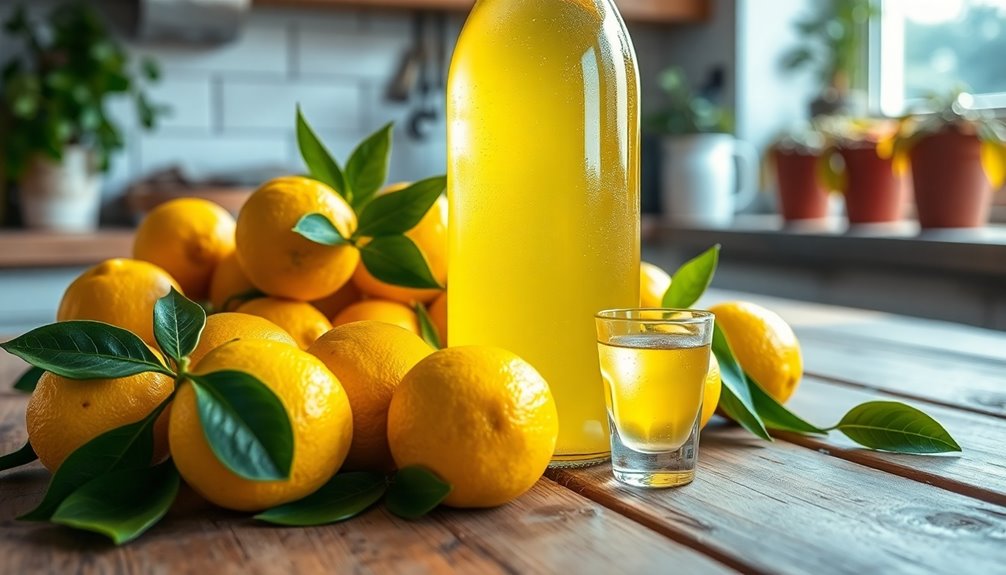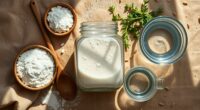To make your own limoncello, start by zesting 10 large organic lemons, avoiding the bitter white pith. Combine the zest with 1 liter of high-proof grain alcohol in a large jar and let it infuse in a cool, dark place for about two weeks. Afterward, strain the mixture into a clean jar. Mix 4 cups of water with 4 cups of sugar to create a simple syrup, adding it gradually to the lemon infusion until you achieve your desired sweetness. Chill and serve in small glasses. You'll uncover more tips and techniques to perfect your limoncello experience soon!
Key Takeaways
- Use 10 large organic lemons to extract vibrant flavor and zest for your limoncello recipe.
- Combine the lemon zest with 1 liter of high-proof grain alcohol or vodka for infusion.
- After infusion, strain the mixture and add 4 cups of granulated sugar gradually for desired sweetness.
- Create a simple syrup by combining 4 cups of water with the sugar, and adjust to taste.
- Refrigerate the final mixture for two weeks to allow flavors to meld before serving chilled.
History
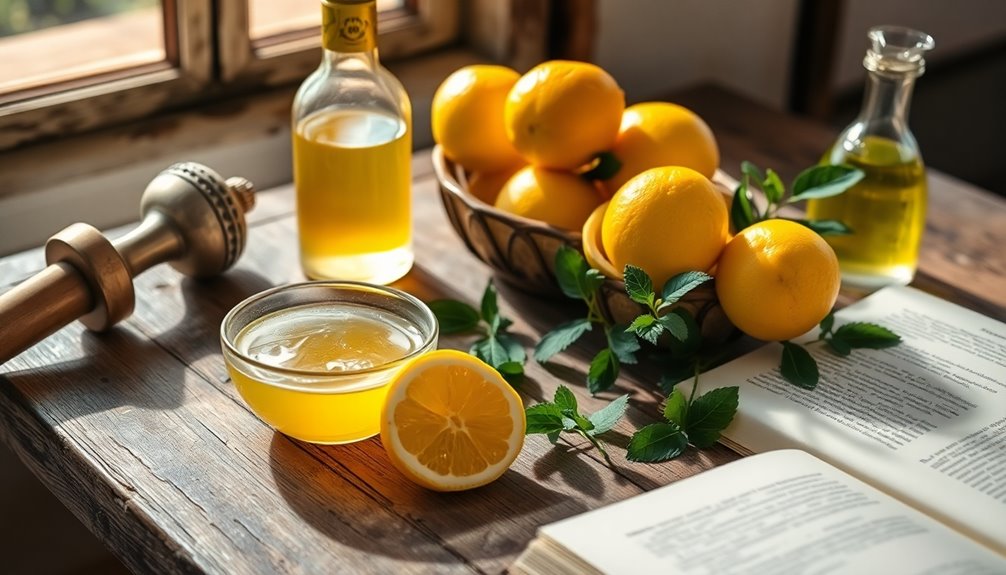
Limoncello's history is as vibrant as its flavor, originating from the sun-soaked Amalfi Coast of Italy. You might find it intriguing that this delightful liqueur dates back to at least the early 20th century, though some say its roots reach even further into Italian tradition.
Locals initially crafted it using lemons from the Sorrento Peninsula, known for their bright zest and aromatic qualities. As you sip this invigorating drink, remember that it was often homemade, shared among families and friends, embodying Italian hospitality.
Over the decades, limoncello gained popularity beyond Italy, enchanting taste buds worldwide. Today, you can enjoy it in various settings, from casual gatherings to elegant dinners, all while savoring a piece of Italian culture.
Recipe
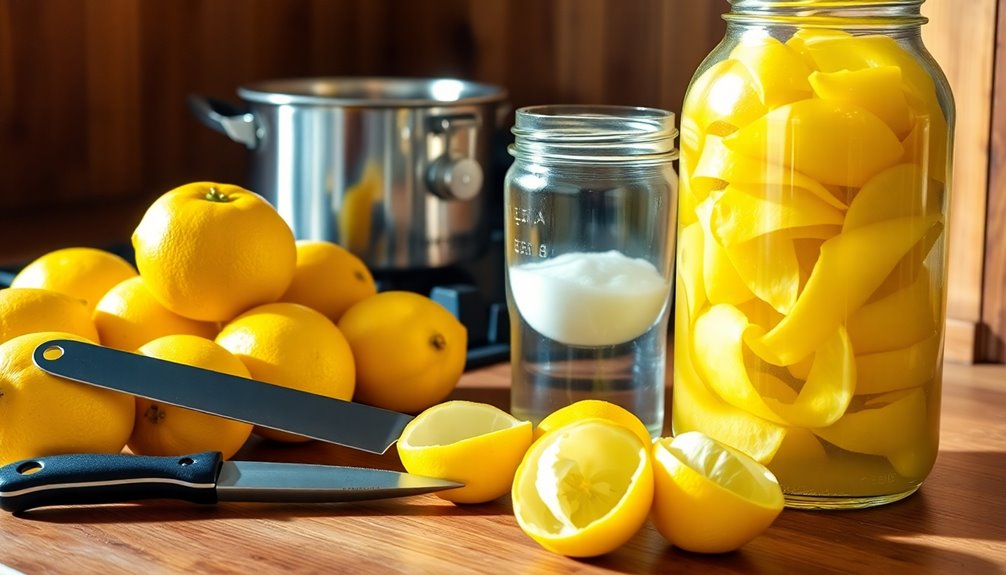
Limoncello is a delightful Italian lemon liqueur that captures the essence of fresh lemons in every sip. Traditionally made in the southern regions of Italy, this vibrant drink is often enjoyed as a digestif after meals. The process of making limoncello is simple yet requires patience, as the key to its phenomenal flavor lies in allowing the lemon zest to infuse the alcohol for several days.
Serve it chilled in small glasses, and you'll find its revitalizing sweetness and tangy brightness perfect for any occasion.
To make your own limoncello at home, start by selecting the freshest, organic lemons you can find. Their zest will be the star of this recipe, so quality matters. The alcohol used is typically a high-proof grain alcohol or vodka, which will help extract the oils from the lemon peels.
Once your limoncello is ready, it can be stored in the freezer for a revitalizing treat on warm days or used in cocktails for a citrusy twist.
Ingredients:
- 10 large organic lemons
- 1 liter of high-proof grain alcohol or vodka
- 4 cups of granulated sugar
- 4 cups of water
Instructions:
Begin by thoroughly washing the lemons to remove any wax or pesticides. Using a vegetable peeler, carefully peel the lemons, avoiding the white pith as it can impart bitterness.
Place the lemon peels in a large glass jar and pour the alcohol over them, ensuring they're fully submerged. Seal the jar tightly and store it in a cool, dark place for at least 7 days, shaking it gently every couple of days.
After the infusion period, combine the sugar and water in a saucepan over medium heat, stirring until the sugar dissolves completely. Allow the syrup to cool, then strain the lemon-infused alcohol into a clean bottle, mix in the syrup, and refrigerate or freeze until ready to serve.
Extra Tips:
For the best flavor, use organic lemons, as they're less likely to contain harmful chemicals on their skin. If you prefer a less sweet limoncello, you can adjust the amount of sugar syrup added to taste.
Additionally, you may experiment with varying the infusion time; some people enjoy a longer infusion for a more intense lemon flavor. Remember to serve your limoncello ice-cold for the best experience!
Cooking Steps
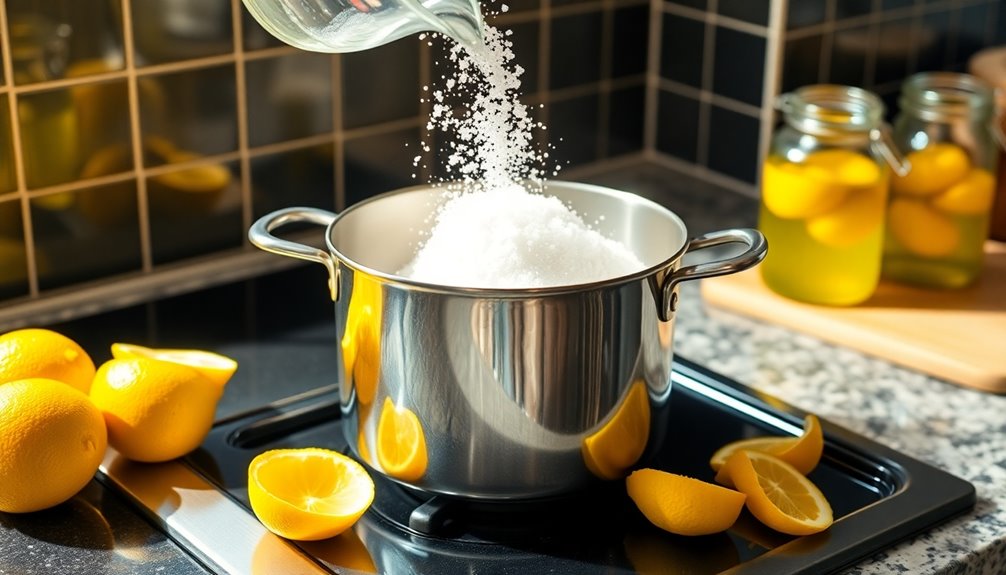
To make your limoncello, you'll start by zesting fresh lemons thoroughly to capture all that bright flavor.
Next, combine the lemon zest with vodka, creating a vibrant mixture.
After that, you'll strain it into a jar and gradually add simple syrup to balance the sweetness.
Step 1. Zest Fresh Lemons Thoroughly

Zesting fresh lemons is an essential step that adds vibrant flavor to your limoncello. Start by selecting firm, bright lemons; the fresher they are, the more flavorful your zest will be.
Rinse the lemons under cool water to remove any wax or pesticides. Using a microplane or a zester, gently scrape off the yellow outer layer of the lemon peel, avoiding the bitter white pith underneath.
Make sure to zest only the outer skin to capture that delightful citrus aroma. As you zest, rotate the lemon to cover all sides evenly.
Aim for about 10-12 lemons to get enough zest for a rich, tangy infusion. Once you've zested them thoroughly, you're ready to move on to the next step!
Step 2. Combine Vodka and Lemon Zest
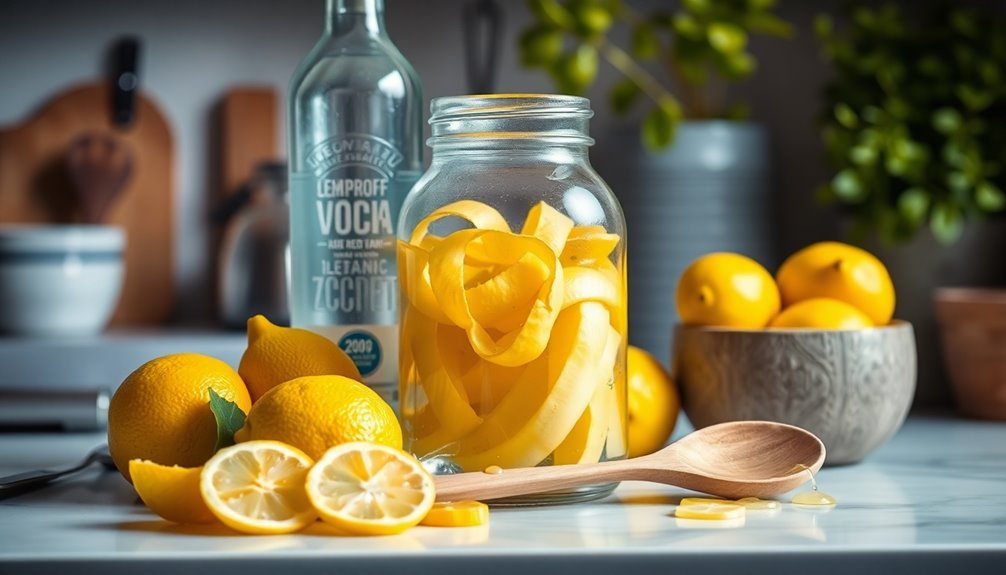
Now that you've prepared your lemon zest, it's time to create the flavorful base for your limoncello.
In a clean, large jar, combine the lemon zest with a bottle of high-quality vodka. Make sure the vodka completely covers the zest; this guarantees maximum flavor extraction.
Seal the jar tightly, giving it a gentle shake to mix everything together. Store the jar in a cool, dark place for about one to two weeks.
During this time, the vodka will absorb the vibrant lemon oils, transforming into a bright yellow infusion. Remember to give the jar a shake every few days to help enhance the infusion process.
You're on your way to crafting a delicious homemade limoncello!
Step 3. Strain Mixture Into Jar
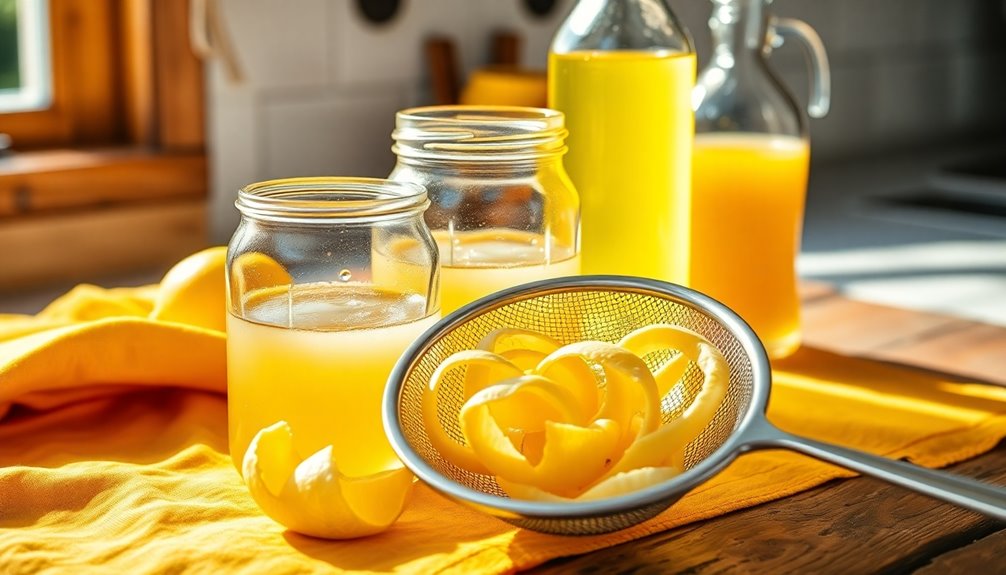
After the infusion period, it's time to strain the mixture into a clean jar.
Begin by placing a fine mesh strainer or cheesecloth over a bowl. Carefully pour the infused vodka and lemon zest mixture through the strainer, allowing the liquid to filter through while catching any solids.
You might need to gently press the solids to extract every drop of that flavorful essence. Once you've strained everything, discard the lemon zest and any remaining residue.
Transfer the strained limoncello into a clean, airtight jar or bottle. Make sure the jar is sterilized to preserve the freshness.
Seal it tightly, and you're all set for the next step in creating your delicious limoncello! Enjoy the bright, zesty aroma!
Step 4. Add Simple Syrup Gradually
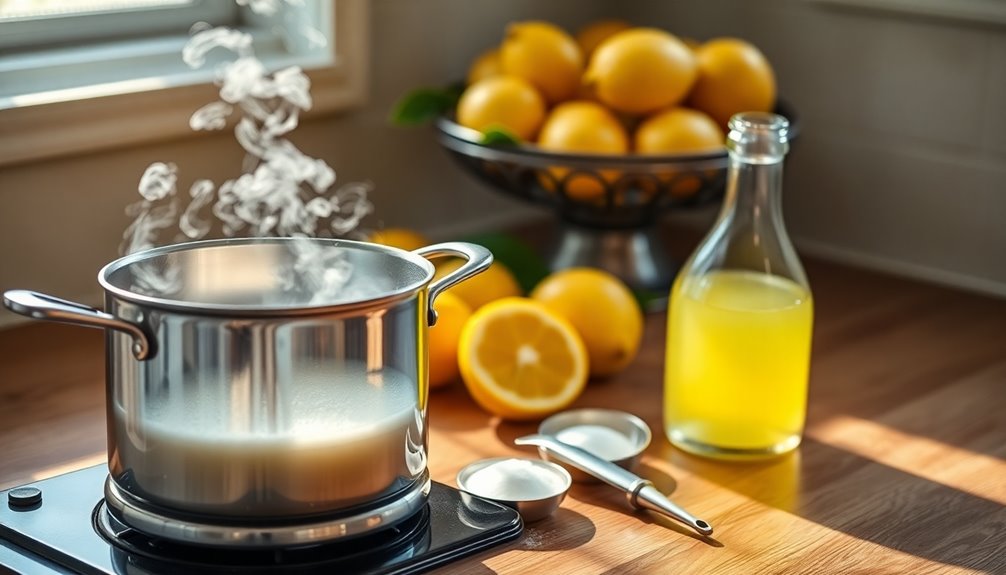
Once you've strained the limoncello into your clean jar, it's time to sweeten the mixture with simple syrup.
Start by adding a small amount—about a quarter cup—to the limoncello. Stir the mixture well, allowing the syrup to blend fully.
Taste it after mixing; you can always add more syrup if you prefer a sweeter flavor. Gradually incorporate the syrup, one quarter cup at a time, tasting after each addition.
This way, you'll achieve the perfect balance of sweetness for your palate. Remember, you can always add more, but you can't take it out, so proceed cautiously.
Once you’ve reached your desired sweetness, give it one final stir, ensuring everything’s well combined. Enjoy the process! Once you’ve reached your desired sweetness, give it one final stir, ensuring everything’s well combined. As you prepare to savor your creation, make sure you have all the necessary moscow mule cocktail ingredients on hand, such as vodka, ginger beer, and fresh lime juice. The right balance of flavors will enhance your experience, making each sip refreshing and delightful. Cheers to your mixology skills!
Step 5. Refrigerate for Two Weeks
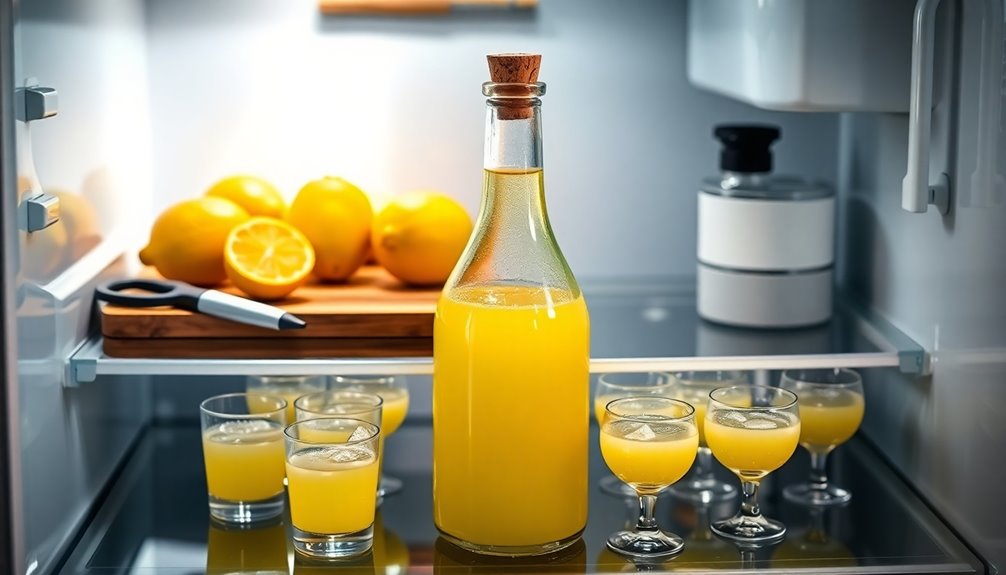
To allow the flavors to meld beautifully, refrigerate your limoncello for two weeks. This step is essential for developing that rich, tangy sweetness you crave.
Make sure you transfer your mixture into a clean, airtight bottle, sealing it tightly to prevent any odors from seeping in. Place the bottle in the coldest part of your refrigerator, ensuring it stays undisturbed throughout the two weeks.
As time passes, the lemon zest infuses its essence, creating a vibrant and aromatic liqueur. You'll notice the color deepening and the flavor becoming more balanced.
Once the waiting period is over, you'll have a invigorating homemade limoncello ready to serve chilled, whether in a glass or as an ingredient in other delicious cocktails. Enjoy!
Final Thoughts
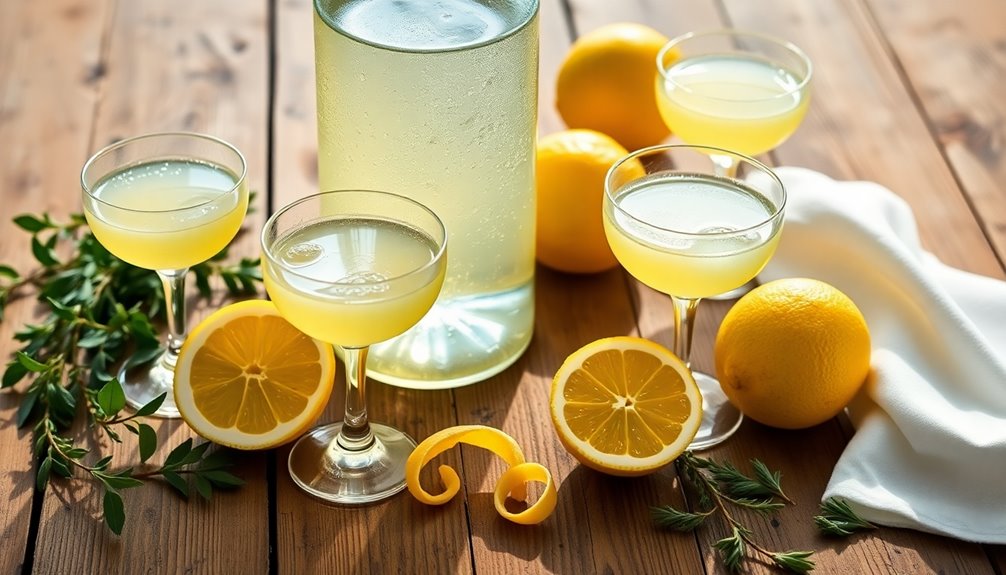
As you savor your homemade limoncello, it's easy to appreciate the joy of creating such an invigorating liqueur.
The vibrant flavors of fresh lemons, infused with the sweetness of sugar, come together to deliver a refreshing experience.
Whether you enjoy it straight from the freezer or use it in cocktails, this Italian delight elevates any occasion.
Frequently Asked Questions
Can I Use Other Citrus Fruits Instead of Lemons?
Absolutely, you can use other citrus fruits instead of lemons! Oranges, limes, grapefruits, or even tangerines can add unique flavors to your creation.
Just keep in mind that each fruit brings its own sweetness and acidity, so you might need to adjust your sugar levels accordingly.
Experimenting with different citrus can lead to exciting new tastes, so don't hesitate to try out various combinations until you find your perfect match!
How Long Does Homemade Limoncello Last?
Homemade limoncello can last quite a while if stored properly.
Generally, it'll stay good for about 1 to 2 years in the freezer or refrigerator. The alcohol acts as a preservative, so it won't spoil easily.
Just make sure you keep it in a tightly sealed bottle to prevent oxidation.
If you notice any changes in flavor or aroma, it might be time to contemplate a fresh batch!
Enjoy responsibly!
Is Limoncello Gluten-Free?
Yes, limoncello is gluten-free!
You'll find that it's typically made from just a few simple ingredients: lemons, alcohol, sugar, and water.
Since none of these contain gluten, you can enjoy it without worry.
Just make sure to check the label of any store-bought versions, as some brands might add extra ingredients that could contain gluten.
But if you stick to the basics, you're in the clear!
Can I Make Limoncello Without Alcohol?
You can definitely create a lemony drink without alcohol! Instead of using spirits, try infusing fresh lemon zest in a mixture of water, sugar, and your favorite non-alcoholic flavorings.
Heat the water and sugar until dissolved, then let it cool with the lemon zest for a few hours.
Strain it and enjoy your revitalizing, non-alcoholic lemon infusion. It's a great way to savor that bright citrus flavor without any alcohol!
What Dishes Pair Well With Limoncello?
When you think about what dishes pair well with limoncello, consider light and invigorating options.
Seafood dishes like grilled shrimp or lemon butter fish enhance its citrusy notes. A simple salad with fresh greens and vinaigrette also complements its brightness.
For dessert, lemon sorbet or cheesecake can create a delightful balance. Even a cheese platter with mild cheeses works well, allowing the limoncello's sweetness to shine through.
Enjoy experimenting with these pairings!
